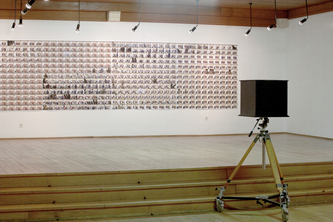|
Imitari - TimeBox
Essay by Sebastjan Leban How are we to break down the reality of contemporary society marked by globalisation and conditioned by continuous technological modernisation? What will be the new revolution of the visible, and what tools are we to develop in order to be able to read and analyse the ever more complex processes of its representation? Development does not only imply the technological progress of society, but also the modernisation of all its segments. As stated by Beller, cinema, television, video, computers and the Internet represent deterritorialized factories in which we, as spectators or users, work. Therefore, in the economy of the visible, looking connotes working. The major contribution to this shift was made by cinema, which, through its cinematic mode of production, transformed the perception of time, reality and fiction, and changed the production process of labour proper. The project Imitari – Timebox addresses the question of the function of image in relation to time and movement characteristic of Deleuze's paradigm of movement-image time-image. Through the analytical apparatus of photography, Radovič places the spectator in the role of the one who (de)constructs each set. The point is not only to build a code for a visual interpretation that allows us to analyse singular shots making up the set (both in reality and fiction), but to activate the spectator in the very act of cutting performed by Radovič himself in the exhibited works. The characteristic film cutting thus becomes a medium for the construction of the photographic work. Radovič transforms the process of the film medium into the photographic medium and vice versa. As argued by Deleuze, cutting is the determination of the shot, and the shot, the determination of the movement which is established in the closed system between elements or parts of the set. In such a way, Radovič uses photography as the medium for the analysis of film narration and the cinematic mode of production, dissecting at one and the same time society and the processes of production through which this last is being shaped. According to Deleuze, film cannot be defined as moving pictures to which movement is added, but rather as an intermediate image to which movement is inherent. Every single element within the set is endowed with its own movement, and, when put together, these elements constitute the paradigm movement-image time-image. Radovič's questioning of this very paradigm through the capacity of defragmentation of the photographic medium opens up new ways of interpreting and understanding the analogue and the digital where time, image and movement are caught between the reality of our fiction and the fiction of our reality. |
Galerija Božidar Jakac /
Lamutov likovni salon Kostanjevica na Krki 23. 7. 2010 - 22. 8. 2010 Curator: Sebastjan Leban Frankfurt 2010
|

|
|















